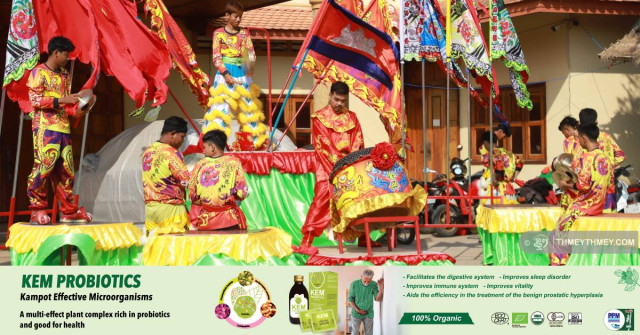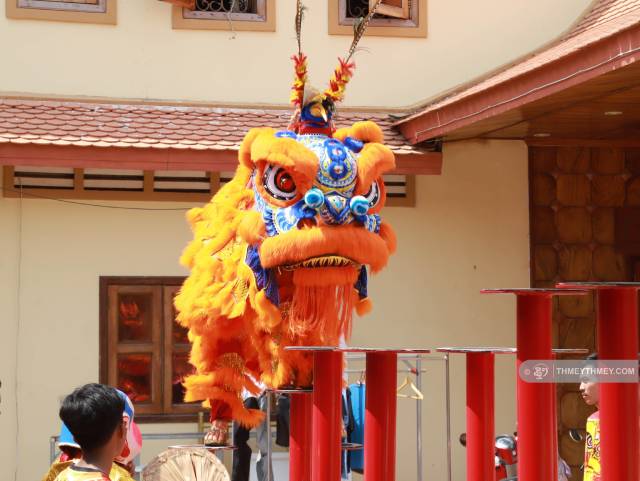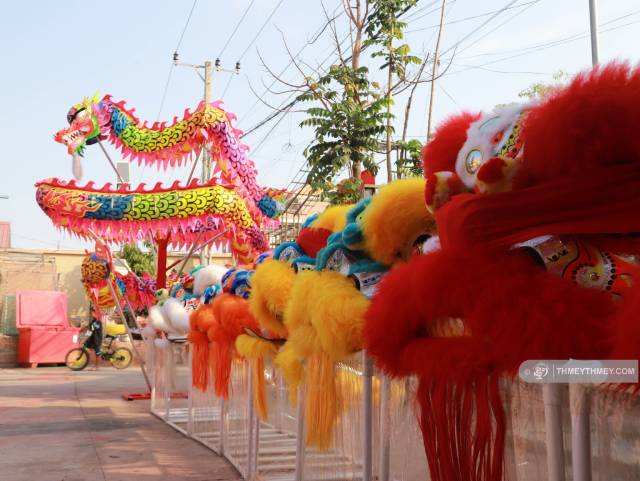Dancers Open the Lions’ Eyes for Chinese New Year

- By Meng Seavmey
- February 7, 2024 9:50 AM
PHNOM PENH – A group performing the Lion Dance held a ceremony to “open the eyes of the lions” to bring good luck for the coming twelve months, while Chinese Lunar New Year celebrations will kick off on Feb. 9.
The annual ceremony aims at closing the old year and freshly starting the new one said David Heng, the manager of the Lion Dance group on Feb. 1.
After four months of rehearsal, the group has put together a new show and is ready to perform at people’s houses or in public areas to celebrate the Year of the Dragon.
 The Dragon Dance. Photo_ Chea Youkeang
The Dragon Dance. Photo_ Chea Youkeang
It is believed the dance chases away evil spirits and brings good luck into the households, David said.
The group, made of 25 young adult dancers, uses traditional music instruments, including lion drums, brass cymbals and gongs, costumes, and steel or bamboo sticks in their show.
The main dance put together eight lions of four different colors: red, yellow, white, and orange.
“In Chinese beliefs, those four colors, especially red, are lucky colors for this year's celebration,” David said.
 Steel Pillars Dance. Photo_ Chea Youkeang
Steel Pillars Dance. Photo_ Chea Youkeang
Right performers for business growth
Even though every dancer has a specific role in the group, coordination is key to making sure the lions move at the same time and in line with the drummers, who give the dance its rhythm.
David believes the group will receive support from the public although they have only been dancing for three years. The activity doesn’t run all year as it is a seasonal operation, but David remains optimistic because managing the group is his passion.
While he runs it as a private company, he emphasizes that the dragon and lion dances are above all a cultural performance that he loved since he was 11 years old, when he first started to perform as a drummer in such a group.
He has since then been following his grandfather’s footsteps and performed in every possible position, from drums to holding the lion’s head or tail.
The group usually trains in the evening four months before the Lunar New Year, from 5 pm to 8 pm. David only accepts performers who can jump as the dance requires, but also gives a lot of attention to their ability to work as a team, given the moves ask for a lot of coordination.
“That is the challenge because some trainers do not listen. There are many people interested in joining, so there are different personalities. I only keep the ones who can get along with others,” he said.
 The Eight Lions Were Blindfolded Before The Ceremony. Photo_ Meng Seavmey
The Eight Lions Were Blindfolded Before The Ceremony. Photo_ Meng Seavmey
Opening the dragon’s eyes for the new year lucks
The one-and-half-hour ceremony is divided into three acts: The bamboo pillar, the steel pillars, and the eight-lion dance.
Before it starts, the dancers open the red blindfolds from the eight lion heads to show the animals are ready for the performance. A lion dancer then steps forward first and climbs the 5-meter-high bamboo pillar.
Carrying the yellow lion, You Nath, 39, uses his feet and arms to pull himself up the pillar. It takes him less than ten seconds to reach the top, at the sound of the traditional drums. He then starts dancing above the crowd.
“The pillar climbing represents the increase of wealth for the people. The tall pillar means rising good luck for the owners of the house where we perform for the new year,” Nath said.
_1707274788.jpg) A group performing the Lion Dance held a ceremony to “open the eyes of the lions” to bring good luck for the coming twelve months, while Chinese Lunar New Year celebrations will kick off on Feb. 9.
A group performing the Lion Dance held a ceremony to “open the eyes of the lions” to bring good luck for the coming twelve months, while Chinese Lunar New Year celebrations will kick off on Feb. 9.
Nath has been dancing for Lunar New Year’s celebrations for around 26 years and has never missed a single year. “I start training my legs a month before the show so that I’m strong enough to climb quickly,” he said. “I try not to get weakened during the climb.”
Even though he is used to it and not afraid of heights, he said the wind is usually his biggest challenge. However, it does not stop Nath from dancing on top of the bamboo stick for more than five minutes.
Rith Soboren, 31, is the steel-pillar dancer. While the meaning of that dance is similar to that of the bamboo stick dance – bring luck and fortune for the year – his show is a lot more challenging.
For several minutes, he and his teammate keep jumping from one steel pillar to another, more than 2 meters above the ground, following the rhythms of the drums and moving the body of his lion.
With 15 years of experience, Soboren needs two to three months to train and practice with another performer before the show season starts.
“There were times I failed and got injured because of the fall. But I am still interested in playing the role,” Soboren said.
His show, on top of the steel pillars, aims to show the natural behaviors of lions such as scratching, shaking of the body, and licking their fur.
After ten minutes, the traditional Chinese instruments suggest it is time for Soboren’s lion to come down to make room for the eight-lion dance grand finale and dragon dance.
This third performance is carried out by nine people who carry a dragon costume from head to tail. The music gets more entertaining with less drumming set, highlighted by the smooth moves of the dragon, traveling across the house’s courtyard or in the street.
The last act of the spectacle shows the eight lions dancing all at once for around five minutes, with acrobatics mimicking the moves of the King of the jungle.
The dragon and lion dances are usually performed during the Lunar New Year celebrations to bring good luck. Dragons represent wisdom, power, and wealth, while lions are auspicious animals symbolizing wisdom, power, and superiority.















